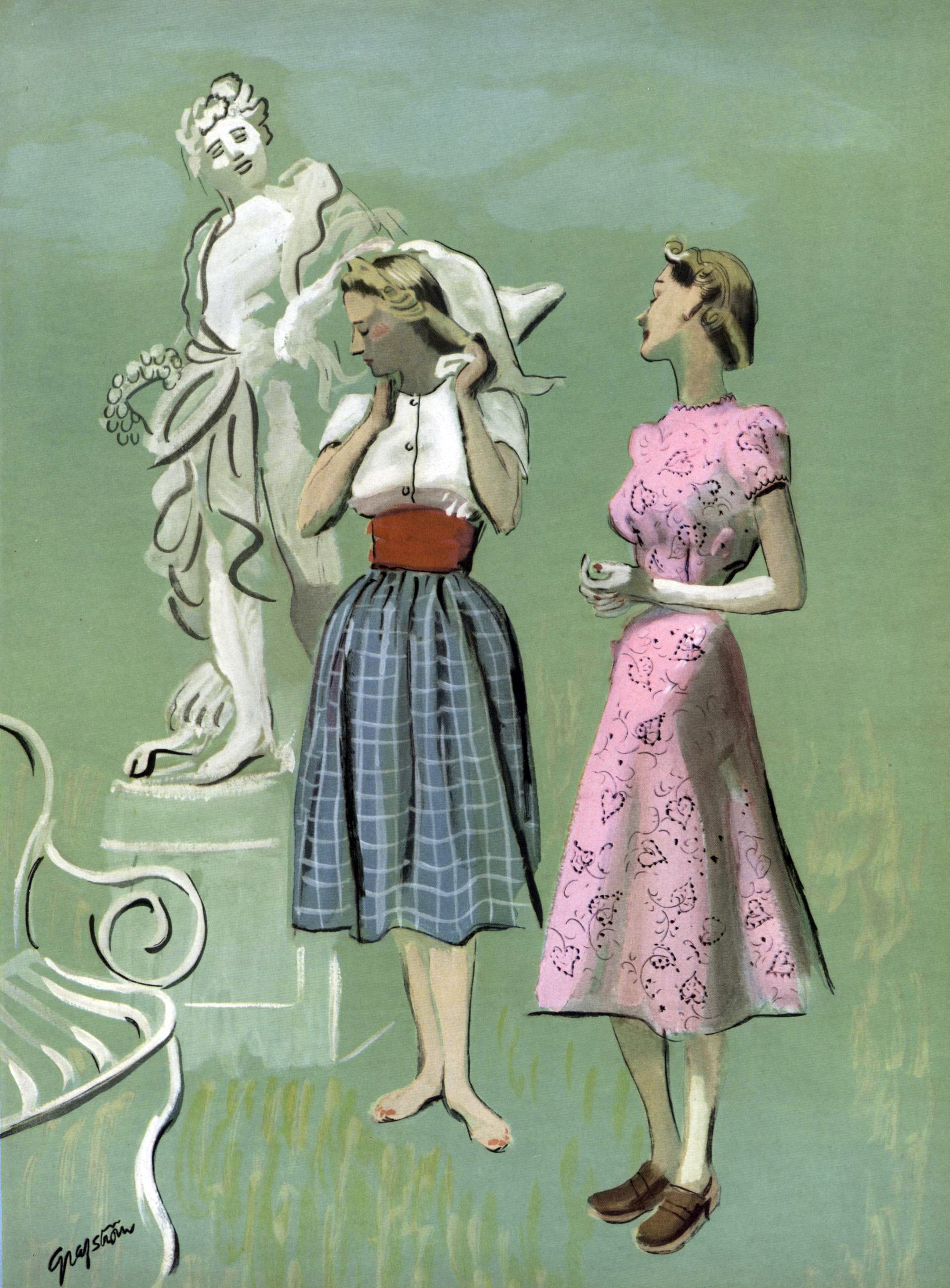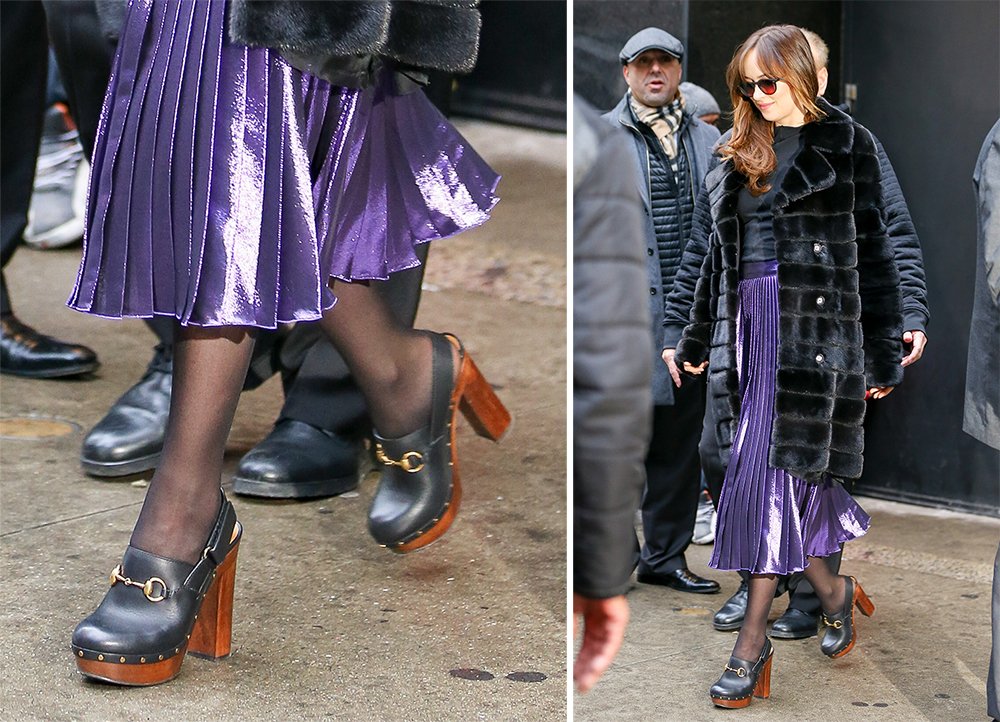tHE HISTORY OF CLOGS: IN AND OUT OF FASHION
Originally published on Heroine in July 2019.
Fashion’s first clogs—“sand clogs” to match bathing costumes by L.C. Studios, 1926.
Though often reviled for their ugliness, clogs have hung around the edges of fashion for almost one hundred years—falling in and out of style but never disappearing, always ready for another generation to discover them. In its most basic definition, a clog is a type of footwear made in part or completely from wood. Aligning closely with their culture of manufacture, three main styles of clogs have been identified: wooden upper clogs, where a piece of solid wood is hollowed out to make a combined upper and lower (these can completely cover the foot like the traditional Dutch klomp or only over the toes like the Italian zoccolo); wooden soled clogs, which combine a wooden sole with a different upper (this can be leather as in English clogs, an open sandal like that Japanese geta, or with a toe peg like the Indian paduka); and overshoes, which combine a wooden sole with straps meant to be worn over other shoes for protection (as in medieval pattens). The history of clogs likely stretches back millennia (possibly to Ancient Greece), though the oldest surviving wooden footwear are proto-klompen found in the Netherlands that date from 1230 and 1280—for all their many centuries of use, there has been very little change in the style or production of clogs within each culture.
“Country dresses for the young” paired with garden clogs in Vogue, April 15, 1938.
An integral part of native dress in many cultures around the world, clogs were valued for their hardiness and protective qualities in addition to the ease with which they could be made from readily available materials. Worn most often for work in agriculture, factories and mines, clogs (in all their variations) have long been regarded by the elite upper-class as part of the dress of the poor, working-class country folk—who by the early twentieth century were beginning in Europe to adopt more conventional styles of shoes. While historians and sociologists mourned the end of the utilization of this aspect of folk dress, clogs were on their path to being remade and refashioned for the urban elite. In May 1926 L.C. Studios in New York showed alongside their collection of bathing costumes “sand clogs,” which Women’s Wear described as “one of the most interesting innovations of the season.” Sand clogs featured wooden soles “painted in bright waterproof colors and they are held to the foot by two broad leather straps painted with either gold or silver gilt.” By 1929 beach clogs had evolved into two different styles: flat sandals with thick platform soles (sometimes with a flexible grooved sole) with a strap or two across, as well as high spike heels out of wood. Though clogs were primarily viewed in the 1920s as more for casual summertime wear, a few designers made them up in satin or embellished the spike-heeled “clogs” with rhinestones and feathers (within a few years these had been renamed mules and were the footwear of choice for all starlets).
Elegant poolside dressing in a pair of high-heeled clog sandals. Photo by Toni Frissell for Harper’s Bazaar, January 1952.
The elites pillaging of folk dress and workwear was high fashion news in 1930, as “the peasant and the working man have set the styles for the best feminine beach clothes, this season, so quite naturally, their footwear, which is both practical and picturesque, is also being copied.” Elsa Schiaparelli and Maggie Rouff showed wooden clogs, while Mary Nowitzky paired her couture beach pajamas with cork clogs built up over the toe in the style of traditional Dutch klompen. The ascent of clogs into high fashion not only adapted their use but also often their materials. Cork was first used to make clogs in 1929, and became quite commonplace over the next two decades due to being more lightweight than wood. As soles grew throughout the 1930s rubber was also used for the fashionable platform clogs—first advertised as a boon for short women, the then-towering 3” platforms surprised many retailers by taking off with women of all heights.
Reading through articles and advertisements it becomes clear that “clogs” is often used as a catchall term for any shoe or sandal with a platform or wedge sole. In 1938 Schiaparelli showed a variety of evening platforms (all designed by Andre Perugia)—flat 3” cork sandals, sculpted soles like waves, high heels with thick platform fronts—that were all described as clogs by the press. While glorifying luxury clogs for evening, Vogue also began to include traditional gardening clogs in their editorials of casual day clothes.
The outbreak of WWII brought rationing of many materials but not wood or cork—leading to an explosion of novelty clogs meant to appeal to women who still wanted something fun to wear without using a ration coupon. Fashionable women in Paris and then New York completed their outfits with sky-high cork or wood clogs and platforms that became the defining look of the resistance.
Marimekko’s lace-up clogs and a matching dress captured by Gordon Parks for Vogue, November 15, 1966.
Associated so closely with the deprivations of the war years, clogs fell out of fashion in the post-war period as fashion shifted to an emphasis on more delicate and feminine styles. Beach clogs (usually just simple 1” wood soles and a leather strap) were sold as vacation wear throughout the 1950s and into the 1960s, but clogs were rarely part of the fashion agenda until the mid-1960s when designers from both America and Scandinavia began to approach anew this forgotten footwear. Famed American shoe label Herbert Levine introduced wooden clogs into their line in 1963, using a variety of different wood types and layered woods to create eye-catching mules and wedge sandals. These took several years to take off, though by 1965 designers realized that clogs—with their heavy sole and infinite possibilities of upper – proved an ideal footwear choice for the new fashions. Clog mules paired well with little mod dresses, while platform clog sandals balanced voluminous, orientalist caftans.
Scandinavian designers approached clogs in a less fashion, more traditional style. Ulla Olsenius moved to New York in 1963 from Sweden as the exclusive importer of clogs for two Swedish factories, yet found few takers for them at her tiny Greenwich Village shop, Olofdaughters. That year she sold only 5,000 pairs, yet by 1969 she had “contracts with eight Swedish factories and sells some 23,000 pairs of clogs a month.” Heavily featured in youth-oriented magazines like Seventeen, Olofdaughters’ primary colored, old-fashioned clogs were described as reflecting “a happy unjaded way of life. They are hip without being world weary.” Marimekko, the Finnish design company known for a bright, modern, joyful total look, brought to the United States their versions of traditional Finnish clogs—black lacquered wooden soles with patterned cotton straps crisscrossing up to the knee or single straps of brightly colored suede—establishing a passion for Scandinavian clogs that continues until today.
Poppy brights, short skirts and Olofdaughters clogs were a teen fashion favorite in the late 1960s and early 1970s. Seventeen, April 1970.
Clogs and platforms were the defining shoes of the 1970s, in every style and material possible. Issey Miyake’s were rainbow-striped with a heavy white wood sole in 1971, while Charles Jourdan combined yellow patent with platform black soles in 1972. In 1978 Candie’s was launched with stiletto heeled mules and clogs made from molded plastic made to look like wood—nicknamed the “disco slide” they appeared on every dance floor across the country and on Sandy’s feet post-makeover in Grease. Two decades later, Candie’s 1997 ads with Jenny McCarthy introduced a new generation to their wood-look clog heels.
Though pumps and sneakers were the footwear of choice in the 1980s, the nostalgia-centric 1990s proved a ripe time for another rebirth of clogs. With thrift store dressing in style and young designers like Marc Jacobs and Anna Sui revisiting the 1970s in their collections, clogs began to appear in a wide array of collections. Karl Lagerfeld’s spring/summer 1992 collection for Chanel featured clogs with made from the quilted leather of the house’s iconic bags, and the same year Thierry Mugler sent towering wood wedge clogs down the catwalk. Though not yet the official creative director of Gucci, Tom Ford made a splash and truly launched his career with the clogs he used in their spring/summer show. Later he said: “It began with the clog. When some people saw that at Gucci, they were scandalized. We were so unsure that we only had six pairs made for the show—with 20 girls to share them… It was sort of a joke, but when it hit the stores, it started selling.” Miuccia Prada launched Miu Miu that same year, with an emphasis on wood-heeled clogs; almost every season since then clogs have appeared on their catwalk, usually with chunky soles and large studs.
Dakota Johnson wearing Gucci’s Amstel platform clogs in 2016.
Clogs continue to inspire designers who are attracted by their folkloric history and 1970s trendiness, as well as young consumers who revel in their comfort and unattractiveness (think Ashley Olsen in a Birkenstock clog). In a recent interview Elizabeth Semmelhack, the senior curator at the Bata Shoe Museum in Toronto, spoke of clogs as connecting “to a kind of boho peasantry; it speaks to this kind of rural past. Fashion is always intimately intertwined with the politics of any given moment. It doesn’t surprise me that we would be leaning back into a nostalgia for a better time.” Alessandro Michele has revisited the clog several times for Gucci, again incorporating the horse-bit buckle that Ford included in 1993 but adding in a very high heel and a slingback. Dior’s DiorQuake clogs premiered in black leather or folksy patchwork for fall/winter 2018 and now come in logo-print canvas, while Lanvin and Molly Goddard have also shown clogs for fall/winter 2019. Swedish Hasbeens and Danskos (an American brand inspired by Denmark) are continuing the Scandinavian clogmania of the 1960s with more affordable versions noted for their style (the former) and their extreme comfort (the latter). New York line No. 6 is said to have “conferred high-style status” on clogs with their cult wooden designs inspired by ‘70s Swedish originals.
Whether or not you consider them attractive, the durability of the original clog seems to have set a standard for their durability in fashion—even when they are not central to runway shows, they have continued to be worn and loved by a huge range of devotees enamored by their easy comfort and history that defies trends.







